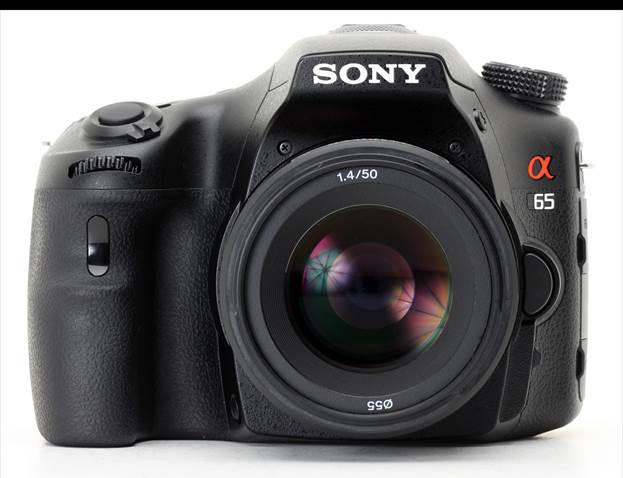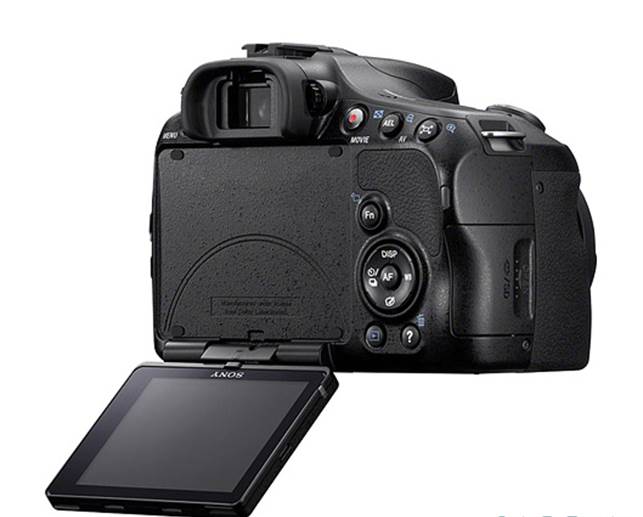Both the Sony Alpha 77 and Alpha 65 were announced at the
same time, and while the A77 generated the most headlines the A65 has been
somewhat overlooked. In many ways it's the A65 that deserves to be the more
popular, due to its impressive specifications and more reasonable asking price.

Sony Alpha 65
Review
Just like the A77, the A65 is based around Sony's SLT technology,
which sees a semi-translucent mirror passing roughly two-thirds of the light
exiting the lens through to the imaging sensor, with the rest bounced up onto
an AF sensor. This means AF is never interrupted, and also that the camera can
achieve a burst rate of 10fps.
This all comes at the expense of the optical viewfinder,
though. In its place there's an OLED electronic alternative with a stunningly
high 2.4-million-dot resolution. This is joined on the rear by a clear, crisp
3in LCD with a 921k-dot resolution, which can be angled for a variety of
shooting positions.

Sony DT 16-50mm
F2.8 SSM zoom lens
The AF system has been cut back from the 19-point system on
the A77 to a 15-point array here, with three of these AF points being
cross-type variants, meaning they're sensitive to both vertical and horizontal
details.
While the A77 benefited from a magnesium body, the A65 has
an all-plastic body shell, which is in line with its rivals. With the rubberised covering that coats the sculptured handgrip, it
feels secure in the hand, and shooting is straightforward.
The 2.4-million-dot resolution of the EVF means it's capable
of displaying the scene with excellent clarity, and as it displays 100% of the
scene (in contrast to many optical viewfinders which trim the edges) it's easy
to ensure accurate framing.

Tru-Finder
viewfinder on the Sony A65
The 15-point AF system may not be quite as advanced as the
A77's 19-point system, but compared to its rivals it more than sticks up for
itself. AF acquirement is fast and precise, with hunting only an issue in
tricky lighting conditions. One of the really clever things with the SLT
technology is that the phase-detect AF system can be used in live view and
video recording, mirroring the experience from the EVF.
The A65 is capable of shooting at up to 10fps (in Continuous
Priority mode) that's good for either 14 Raw files or
18 JPEGs before the buffer needs to be cleared. Very impressive stuff.
Multi-segment metering performs very well, producing
well-exposed shots in most conditions, although at times you'll need a touch of
exposure compensation to lift slightly underexposed images. Images display a
smooth tonal range, while there's the D-Range Optimiser
to rescue detail in high-contrast, backlit scenes. Note that this is a JPEG
only option though. Auto white balance gives pleasing results.
The 24.3MP sensor delivers excellent detail and sharpness,
with this high resolution allowing you to print images to A2 at 240dpi without
the need to upscale them. From the base sensitivity to ISO 3200 results display
minimal levels of image noise, with usable results past this point too.
Verdict
The A65 is a great-performing mid-price DSLR. Image quality
is superb and the EVF is one of the best around. Furthermore the SLT
construction makes it a particularly good option for those looking to record
high-quality videos, although with so much reliance on the rear display and EVF
it's not surprising that battery life is a little poor.
Key specs ·
Sensor: 24.3MP (APS-C) ·
File formats: Raw, JPEG, Raw + JPEG ·
Shutter speeds: 30-1/4000sec, Bulb ·
ISO: 100-16,000 ·
Exposure modes: Auto, Auto+, Scene, PASM ·
Drive modes: Single, Continuous, Self-timer,
Bracketing ·
Movie modes: 1920 x 1080 (50p) ·
Display: 3in vari-angle
LCD, 921k dots ·
Viewfinder: EVF, 2.4m dots ·
AF points: 15 (including 3 cross-type sensors) ·
Built-in flash: GN 10m at ISO 100 ·
Memory card: MS Pro Duo, SD, SDHC, SDXC ·
Power: Rechargeable Li-ion battery ·
Dimensions: 132.1 x 97.5 x 80.7mm ·
Weight: 543g (excluding battery and memory
card) Best for ·
An all-round blend of features, performance and
image quality ·
High-quality video recording ·
Enthusiast photographers on a budget Alternatives ·
Canon EOS 600D $1,243.95 ·
Nikon D5100 $1,293.71 ·
Sony Alpha 77 $1,907.39 Pros ·
Ultra-fast performance ·
Class-topping specification ·
Easy to use ·
Video recording Cons ·
EVF one of the best but still not perfect ·
Poor battery life
|